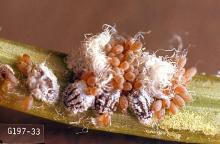Adelges cooleyi
Pest description and damage This aphid-like insect feeds on new needle growth of Douglas-fir. Adelgids appear as woolly or cottony tufts on the undersides of needles; heavily infested trees appear to be flocked. Small (0.04 to 0.07 inch in length) purplish insects are found underneath the cottony tufts. Adelgid feeding can cause needles of Douglas-fir to become distorted or bent and yellow. Infested needles turn brown and sometimes drop prematurely. This pest is a serious concern in Christmas tree plantations but is less important in the landscape. Cooley spruce gall adelgids also infest spruces, but the distinctive galls on spruce do not occur on Douglas-fir.
Biology and life history The biology of this pest is complex with the insect alternating between Douglas-fir and spruce and cycling on the Douglas-fir.
Management-cultural control
Plant Douglas-fir and spruce as far apart as possible. Hand-wipe small infestations.
Management-chemical control
See Table 1 in:
Chemical Control of Landscape Pests
For more information
See "Douglas-fir" in:





